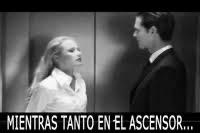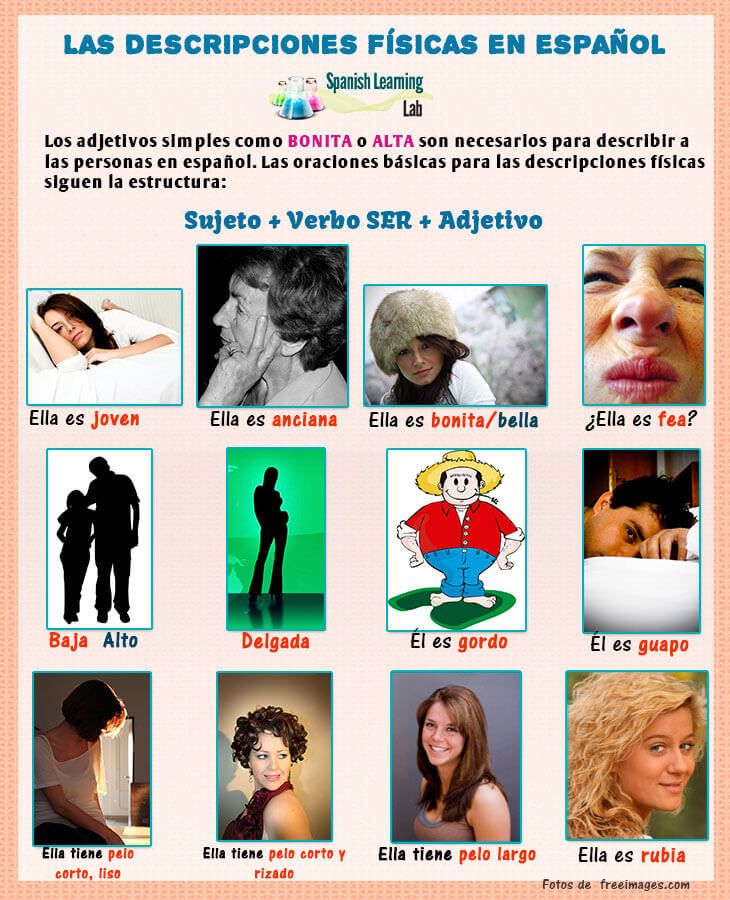Semana (week) 1 (Saludos, el alfabeto, y adjetivos)
Bienvenidos
Welcome to Span 1010 at Utah Tech, we are so happy to have you in our class.
During this semester, we will all work together to improve this new book. Be patient with us, and let us know if something is not working.
Without further ado, let's begin!
Los saludos (greetings) y cortesía (pleasantries)
Saludos y cortesía y expresiones útiles
| 1. bienvenido(s) | welcome | 23. bueno | you're welcome (used when effort involved) |
| 2. buenos días | good morning | 24. repita, por favor | repeat please |
| 3. buenas tardes | good afternoon | 25. escuche(n) | listen |
| 4. buenas noches | good evening/good night | 26. más despacio | slower |
| 5. hola | hi/hello | 27. (yo) soy estudiante | I am a student |
| 6. ¿Cómo estás (tú)? | How are you?(informal) | 28. ¿Cómo te llamas (tú)? | What is your name? (informal) |
| 7. ¿Cómo está (usted)? | How are you? (formal) |
29. ¿Cómo se llama (Ud.)? | What is your name? (formal) |
| 8. (muy) bien, gracias | (very) well, thank you | 30. Me llamo ____ | My name is ____ |
| 9. así así/más o menos | so-so | 31. mucho gusto | please/nice to meet you |
| 10. regular | ok/fine | 32. el gusto es mío | the pleasure is mine |
| 11. bastante bien | pretty well, well enough | 33. igualmente | likewise, same here |
| 12. adiós | goodbye | 34. encantado/a | delighted |
| 13. hasta mañana | until tomorrow | 35. ¿Qué tal? | How's it going? What's up? |
| 14. hasta luego | until later | 36. ¿Qué pasa? | What's happening? |
| 15. nos vemos | see ya | 37. Que te/le vaya bien | Have a good one, hope it goes well |
| 16. mal | bad, poorly | 38. ¿Y tú/Ud.? | And you? |
| 17. (con) permiso | excuse me, pardon me (beforehand) | 39. no entiendo/no comprendo | I don't understand |
| 18. lo siento | I'm sorry | 40. mi(s) amigo(s) | my friend(s) |
| 19. perdón | excuse me, pardon me (after the fact) | 41. señor | Sir, Mr. |
| 20. por favor (por fa*) | please (*cutesy like) | 42. señora | Ma'am, Mrs. |
| 21. gracias | thank you | 43. ¿Cómo se dice___? | How do you say ___? |
| 22. de nada/no hay de qué | you're welcome/no problem | 44. ¿Qué quiere decir___? | What does ___ mean? |
| ¿Hay preguntas? | Are there any questions? | Tengo una pregunta. | I have a question. |
Una conversación simple
One of the simplest conversations (and sometimes an uncomfortable one) is the one you might hold when you meet a neighbor in an elevator or while waiting in a line.
For example:

Laura: ¡Hola, Pedro! ¿Cómo estás?
Pedro: ¡Hola, Laura! Bien, gracias. ¿Y tú?
Laura: Bien, gracias. ¿Qué tal el día?
Pedro: Bien. Estoy deseando llegar a casa. ¿Y tú?
Laura: Yo también. Bueno, es mi piso. ¡Hasta luego, Pedro!
Pedro: ¡Hasta luego, Laura!
During this semester, we will hold a lot of conversations in class, remember to always start and close the conversation in a polite way.
¿Cómo te llamas? - What’s your name?
These greetings and conversation starters can also be used with people we don’t know. If we don’t know their names, we should ask them. We might have to spell our names, so it is useful to learn the ABCs in Spanish.
El alfabeto o abecedario
| A | A |
| B | Be, be grande |
| C | Ce |
| D | De |
| E | E |
| F | Efe |
| G | Ge |
| H | Hache |
| I | I (i latina) |
| J | Jota |
| K | Ka |
| L | Ele |
| M | Eme |
| N | Ene |
| Ñ | Eñe |
| O | O |
| P | Pe |
| Q | Qu |
| R | Ere, erre |
| S | Ese |
| T | Te |
| U | U |
| V | Ve, uve, ve chica |
| W | Doble ve, doble u |
| X | Equis |
| Y | I griega |
| Z | Zeta |
Por ejemplo:
- ¿Cómo te llamas? (Informal)/ ¿Cómo se llama? (Formal)
- Me llamo Alfonso.
- ¿Cómo se escribe tu/ su nombre?
- Se escribe así: a, ele, efe, o, ene, ese, o.
Let’s practice
Find 3 classmates you haven’t talked to yet, and have a little conversation.
Remember to use everything we’ve seen so far: starters, asking and spelling names, and closing conversations politely.
Concordancia nombre-adjetivo
We have already stablished that nouns in Spanish have a specific grammatical gender, either masculine or feminine. One of the biggest differences between Spanish and English is that adjectives also have a gender, and it changes to match the gender of the noun that it is describing. The other big difference is the placement: adjectives are usually placed after the noun they are describing or after the verb ser.
Blue dress - Vestido azul.
Wait a minute, do you remember what an adjective is? It is a word that describes an attribute, added to or grammatically related to a noun to modify or describe it.
Don't forget about the number too! Nouns and adjectives have to agree in gender AND number!
If the noun you are using is masculine-singular, the adjective must be masculine-singular as well. It’s important to note that while the gender of nouns is an inherent property, adjectives do not have this inherent characteristic. The gender of an adjective will change according to the noun it modifies.
| El chico | listo | Los chicos | listos |
| La chica | lista | Las chicas | listas |
If a masculine singular adjective ends in a consonant or a vowel other than -o (most commonly -e), it does not change for gender, because it can be both, but it will change for number:
| el libro interesante | los libros interesantes |
| la noticia interesante | las noticias interesantes |
ChatGPT created activity:
In order to describe people, we will need to use these verbs:
Ser – to be (yo soy, tú eres, él/ella/usted es, nosotros/as somos, vosotros/as sois, ellos/as, ustedes son).
- El chico es alto. El pelo es ondulado. El pelo es canoso. Los niños son rubios. La señora es canosa.
Llevar – to wear (yo llevo, tú llevas, él/ella/usted lleva, nosotros/as llevamos, vosotros/as lleváis, ellos/as/ ustedes llevan).
- El chico lleva un traje negro. Lleva bigote y barba.
Tener – to have (yo tengo, tú tienes, él/ella/usted tiene, nosotros/as tenemos, vosotros/as tenéis, ellos/as/ustedes tienen).
- El chico tiene el pelo ondulado. El hombre tiene ojos azules. Tiene bigote y barba.
Physical Description

Other physical characteristic words
| ojos azules, verdes, cafés o castaños, negros | blue, green, brown, black eyes | viejo/a | old |
| moreno/a | brunette *can also refer to darker skin color | promedio/a | average |
| fuerte/débil | strong/weak | mediano/a, edad mediana | mid-sized, middle-aged |
| pelirrojo/a | red haired | corpulento/a | stocky, hefty |
| calvo/a | bald | curvado/a | curved, curvy |
adjetivos-apariencia-espanol-spanish-physical-appearance-adjectives-pdf-worksheet
For more activities, visit this link: https://www.spanishlearninglab.com/describir-personas-en-espanol/
*Cognates (cognados)
A cognate o cognado is a word that looks like, sounds like, and means the same thing as a word in English. El problema is a cognado. Cognates help us recognize words that are similar and thus help us in understanding and learning words quickly.
This does NOT mean you can make up words by making is sound "Spanish-y". BEWARE, there are also false cognates (cognados falsos). Embarazada looks like embarrassed, kind of sounds like embarrassed, but means pregnant.
Personality descriptions (which are *cognados?)
| agresivo/a | agressive | entusiasta | enthusiastic |
| difícil | difficult | materialista | materialistic |
| impulsivo/a | impulsive | tacaño/a | cheap |
| simpático/a | nice | cómico/a | funny |
| anitpático/a | mean | estudioso/a | studious |
| egoísta | selfish | mentiroso/a | lying |
| inteligente | intelligent | temperamental | temperamental |
| sincero/a | sincere | conservador/a | conservative |
| callado/a | quiet, reserved | filosófico/a | philosophical |
| perezoso/a | lazy | tímido/a | shy |
| considerado/a | considerate | generoso/a | generous |
| práctico/a | practical | tonto/a | silly, dumb |
| creativo/a | creative | idealista | idealistic |
| serio/a | serious | trabajador/a | hardworking |
| terco/a | stubborn | valiente | brave |
| Físico | Ropa | Personalidad |
| Es alto y tiene el pelo moreno. | Lleva vaqueros y un jersey azul. | Es cómico y trabajador. |
Lee tu descripción, vamos a adivinar quién es.
Now, let's practice some more:
- Pair Activity:
- Have students pair up and sit facing each other. Each student should have a blank sheet of paper and a pen.
- Description Time:
- Student A will describe the imaginary person on their character card to Student B, using the adjectives they've learned. For example, "Mi amigo es alto y simpático."
- Student B listens and tries to draw a rough sketch of the described person based on the given traits.
- Switch Roles:
- After a few minutes, switch roles. Now, Student B describes their imaginary person to Student A.
- Sharing Creations:
- Invite a few pairs to share their descriptions and drawings with the class. This encourages speaking and listening skills.
How do we express negative ideas in Spanish?
- Yo NO llevo falda ⇒ ”No” precedes the verb.
- No tengo ninguna falda ⇒ Double negations are ok in Spanish!
- ¿Te gustan las faldas?
- No, no me gustan las faldas ⇒ We may repeat “no” when stating "No, X don’t/ doesn’t …”
- ¿Te gustan las faldas? - No, prefiero los vestidos ⇒ if we answer by giving extra information, there is no need to repeat the question.
- If you want to say "not" it is still no and still goes BEFORE the verb.
- I am not mean. No soy antipático.
- It is not good. No es bueno.
Es no bueno.is not Spanish.
Let's practice!
- Create 10 yes/no questions ¿? (about clothes/ personality/ physical traits)
- For example: ¿Llevas pantalones en una cita?
- Habla con 2 compañeros y responde a sus preguntas.
USEFUL WORDS: Llevar, ser, tener, TE GUSTA/ ME GUSTA (you like/ I like), Anyone/ someone – alguien, no one – nadie/ ninguna. (almost) Everyone – (casi) todos
...
¿Cómo estás?
¿Cómo te llamas?
¿Qué pasa?
¿Qué tal?
¿Entiendes?
¿Cómo se escribe tu nombre?
¿Cómo eres? (What are you like?)

